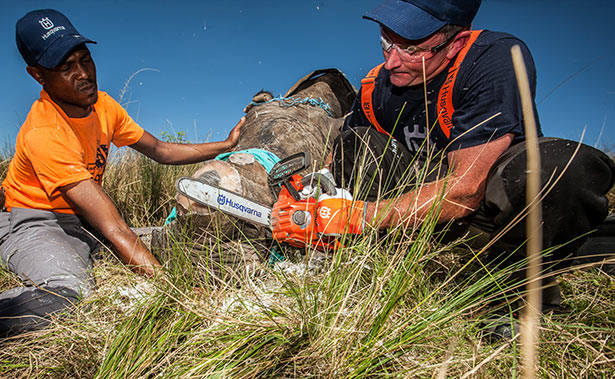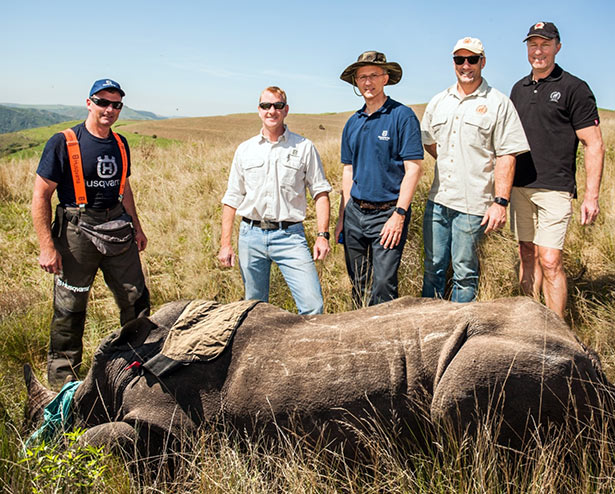IN THE HEADLINES
Read all about it ...
Partnering up in KwaZulu-Natal to save rhinos
The beautiful 700ha Gwahumbe Game & Spa in Mid-Illovo, KwaZulu-Natal, is the latest private reserve to join the ranks of others which have dehorned their rhinos. Its partnership with Husqvarna and Hilton veterinary surgeon Dr Ryan van Deventer will, hopefully, ensure the survival of the lodge’s last remaining male rhino, eight-year-old Vuyo – and finally allow the expansion of its herd.

Caption: 2 people pic - Siya Ndlela & Hilton veterinary surgeon Ryan van Deventer. (Photo Credit: Chris Laurenz)
Previously, said Gwahumbe Game & Spa director Shanon MacKenzie, “We were too anxious about Vuyo’s safety to allow him to be photographed, and we postponed adding to the herd because of the risk of poachers wanting their horns. We are extremely fond of him: he came here when he was just three. The decision to dehorn him was made with his survival and safety very much at the forefront of our minds.”
The devastating decline in the rhino population – and the poachers’ savagery– is just one of the issues on the agenda for this year’s CITES COP17 Conference* (24 September-5 October in Johannesburg). Sadly, the battle for the animal’s survival has been a losing one, until recently.
A local rhino-dehorning campaign, using Husqvarna outdoor power products, is proving highly successful in the bid to save these beautiful animals from poachers. In KwaZulu-Natal, particularly, the practice is gaining momentum, with increasing numbers of private game reserves voting for this option.
The process was first used to help reduce poaching pressure in Zimbabwe in the 1980s. When rhinos are dehorned professionally, the horn is taken above the growth layer of the skin. Rhino horn is like a fingernail: you can cut it or trim it without stopping continued growth. But poachers brutally uproot the entire horn from its base under the skin in the bone.
Vet Dr Ryan van Deventer started working on the dehorning project a year ago in various KwaZulu-Natal areas, including, more recently, at the popular Gwahumbe Game & Spa.
“Before dehorning, many rhino owners used ankle bracelets and horn transmitters for monitoring purposes,” he said. “Although some of them are still resistant to dehorning, as the poaching problem escalates more and more reserves are realising they need to minimise the risk to the animals. It’s not a total solution to the problem but merely part of a holistic plan to try to prevent poaching.”

Caption: Group pic – Ryan van Deventer (Hilton veterinary surgeon), Dylan Lane (Husqvarna), Pavel Hajman (Husqvarna), Stefan Terblanche (CEO of Rugby Legends & former Springbok) & Craig MacKenzie (Gwahumbe Game & Spa). (Photo Credit: Chris Laurenz)
The Husqvarna Group, a global frontrunner in the manufacture of forest, agricultural and garden power products, has provided Van Deventer with a battery chainsaw and a petrol one – the petrol saw for the initial cutting, and the battery saw for the finer trimming.
Some vets who work with rhinos are also relying on Husqvarna’s battery blowers to keep the rhino cool during the dehorning process. Battery products are fuel free so produce no harmful emissions. They are also quieter than their petrol equivalents and lower noise levels mean less anxiety for the sedated animal.
“The Husqvarna chainsaw is quicker than an oscillating saw,” said Van Deventer. “Once the animal is immobilised and stable, the procedure takes about 20-30 minutes.” He said the Husqvarna blower played a vital role in keeping the rhino’s core body temperature down, which was particularly important during the procedure, especially in the hotter seasons. “There is always a risk with anaesthesia, and added to this is that white rhinos are particularly sensitive to the opioids. So we want to perform the dehorning as efficiently and quickly as possible.”
He said the recommended method to reduce poaching risk was to remove the horn as low to the base as possible, in addition to removing the side walls of the horn. This just leaves a small rounded bump of horn, reducing the poaching risk to the animal.”
Horns do grow back with time, but the rate depends on nutrition. “Animals receiving a lot of supplementary feeding have faster horn growth, so dehorning every 15-24 months is a good guide. But saying that, it’s not good enough to merely dehorn and expect there to be no poaching threat: you must ensure other checks are also in place.”
The plight of the rhino has gained international attention, and around the globe, various campaigns are creating awareness and raising funds to help conserve the animal.
Stefan Terblanche, former Springbok rugby player and CEO of the Rugby Legends, has added his voice to the chorus: “We must do all we can to reduce rhino poaching and I’m proud that we can help save the animal for future generations. It’s far better to have a dehorned rhino that is alive and that we can still enjoy seeing in our reserves.”
Husqvarna South Africa’s marketing manager Jacqui Cochran said: “We are extremely committed to this project, and thrilled that our diverse range of equipment is being used for a cause as worthwhile as saving the rhino.”
For more information about Husqvarna, visit www.husqvarna.co.za and www.gwahumbe.co.za
Ends
Editors’ notes
At the beginning of the 20th century, 500,000 rhinos wandered across Africa and Asia. This dropped to 70,000 by 1970 and today, in the wilds, only about 29,000 rhinos remain.
Since 2008, poachers have killed at least 5 940 African rhinos, and poaching is at crisis point. By the end of last year, the number of African rhinos killed by poachers had increased for the sixth year in a row, with at least 1,338 of them killed by poachers across Africa. One horn can sell for up to R150 000 locally, but fetch as much as R5 million in the East, where it is highly prized in traditional Asian medicine for treating various illnesses.
CITES (the Convention on International Trade in Endangered Species of Wild Fauna and Flora) is an international agreement between governments. Its aim is to ensure international trade in specimens of wild animals and plants does not threaten their survival.
About Husqvarna
Since starting out in 1689, Husqvarna Group has manufactured a wide range of quality products. Excellent engineering skills, a strong entrepreneurial spirit and a passion for quality products has led to innovative solutions, successfully taking the company from weapons to today’s cutting-edge outdoor power products.
Throughout the years, Husqvarna has proved its technological leadership by introducing ground-breaking and award-winning solutions and products:
- X-Torq®, predominantly used in handheld products, delivers lower fuel consumption and reduced exhaust emission levels, in accordance with the world´s most stringent environmental regulations.
- AutoTune™, a technological and environmental breakthrough in professional chainsaws, which minimises exhaust emissions and optimises engine performance, omitting the need to spend time on carburettor adjustments.
- Battery powered products that are lightweight, quiet and free from direct emissions but still offer petrol performance.
- Robotic lawn mowers: silent, self-operating mowers that free up time for homeowners and facility managers and consume very little energy.
- Demolition robots for the construction industry: equipped with remote control, they enable demolition tasks in areas where it is too dangerous for workers to enter.
Today, Husqvarna products are hard at work in parks, forests, construction sites, farms, small holdings, estates, golf courses and homes around the world - giving craftsmen and commercial operators as well as hobby users the confidence to perform at the highest level.
About Gwahumbe Game & Spa
Gwahumbe Game & Spa, less than an hour from Durban and Pietermaritzburg near the picturesque town of Mid-Illovo, is a world away from the hustle and bustle of hectic city life.
Known for its majestic cliff faces and lush riverine vegetation, this peaceful private reserve is home to a rhino, hippo, giraffe, zebra, a variety of antelope and an abundance of bird life.
With both catered and self-catered accommodation ranging from the award winning four star AA-accredited lodge to a more rustic experience at the Mzigi bush camp, Gwahumbe is perfect for romantic escapes, family getaways, 4x4 adventure trails, weddings and corporate meetings.
Facilities include a fully equipped conference centre, swimming pool, bar and a beautiful new boma for delicious potjies or braais. The elegant lodge restaurant is known for its good food and wine cellar.
Activities include challenging 4x4 trials, mountain biking, game walks and hikes, bird watching and fishing. The Spa@Gwahumbe, set in its own tranquil private garden, boasts massage rooms, a hydro bath and a steam room. It offers packages for the whole family.
Ends